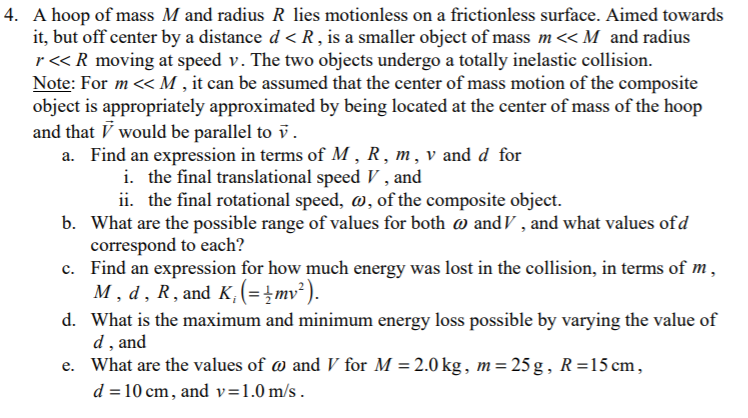4. A hoop of mass M and radius R lies motionless on a frictionless surface. Aimed towards it, but off center by a distance d < R, is a smaller object of mass m<< M and radius r« R moving at speed v. The two objects undergo a totally inelastic collision. Note: For m <« M , it can be assumed that the center of mass motion of the composite object is appropriately approximated by being located at the center of mass of the hoop and that V would be parallel to v. a. Find an expression in terms of M , R , m, v and d for i. the final translational speed V , and ii. the final rotational speed, w, of the composite object. b. What are the possible range of values for both @ and V , and what values ofd correspond to each? c. Find an expression for how much energy was lost in the collision, in terms of m, M, d, R, and K,(=}mv² ). d. What is the maximum and minimum energy loss possible by varying the value of d, and e. What are the values of w and V for M = 2.0 kg, m= 25 g, R=15 cm, d = 10 cm, and v=1.0 m/s . %3D
4. A hoop of mass M and radius R lies motionless on a frictionless surface. Aimed towards it, but off center by a distance d < R, is a smaller object of mass m<< M and radius r« R moving at speed v. The two objects undergo a totally inelastic collision. Note: For m <« M , it can be assumed that the center of mass motion of the composite object is appropriately approximated by being located at the center of mass of the hoop and that V would be parallel to v. a. Find an expression in terms of M , R , m, v and d for i. the final translational speed V , and ii. the final rotational speed, w, of the composite object. b. What are the possible range of values for both @ and V , and what values ofd correspond to each? c. Find an expression for how much energy was lost in the collision, in terms of m, M, d, R, and K,(=}mv² ). d. What is the maximum and minimum energy loss possible by varying the value of d, and e. What are the values of w and V for M = 2.0 kg, m= 25 g, R=15 cm, d = 10 cm, and v=1.0 m/s . %3D
Classical Dynamics of Particles and Systems
5th Edition
ISBN:9780534408961
Author:Stephen T. Thornton, Jerry B. Marion
Publisher:Stephen T. Thornton, Jerry B. Marion
Chapter9: Dynamics Of A System Of Particles
Section: Chapter Questions
Problem 9.6P
Related questions
Question

Transcribed Image Text:4. A hoop of mass M and radius R lies motionless on a frictionless surface. Aimed towards
it, but off center by a distance d < R, is a smaller object of mass m<< M and radius
r« R moving at speed v. The two objects undergo a totally inelastic collision.
Note: For m <« M , it can be assumed that the center of mass motion of the composite
object is appropriately approximated by being located at the center of mass of the hoop
and that V would be parallel to v.
a. Find an expression in terms of M , R , m, v and d for
i. the final translational speed V , and
ii. the final rotational speed, w, of the composite object.
b. What are the possible range of values for both @ and V , and what values ofd
correspond to each?
c. Find an expression for how much energy was lost in the collision, in terms of m,
M, d, R, and K,(=}mv² ).
d. What is the maximum and minimum energy loss possible by varying the value of
d, and
e. What are the values of w and V for M = 2.0 kg, m= 25 g, R=15 cm,
d = 10 cm, and v=1.0 m/s .
%3D
Expert Solution
This question has been solved!
Explore an expertly crafted, step-by-step solution for a thorough understanding of key concepts.
This is a popular solution!
Trending now
This is a popular solution!
Step by step
Solved in 8 steps with 7 images

Recommended textbooks for you

Classical Dynamics of Particles and Systems
Physics
ISBN:
9780534408961
Author:
Stephen T. Thornton, Jerry B. Marion
Publisher:
Cengage Learning

Classical Dynamics of Particles and Systems
Physics
ISBN:
9780534408961
Author:
Stephen T. Thornton, Jerry B. Marion
Publisher:
Cengage Learning